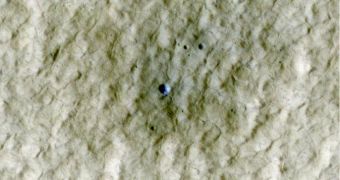A recent image obtained by NASA shows that a young crater on the Martian surface still contains water-ice, a discovery that may shed more light on the planet's troubled past.
The data were collected using the High Resolution Imaging Science Experiment (HiRISE) camera aboard the NASA Mars Reconnaissance Orbiter (MRO), which has been circling Mars for years.
The hidden cache of water-ice was discovered lying at the bottom of a very small crater, which researchers estimate is just 6 meters, or 20 feet, wide.
Datasets collected by the MRO reveal that the crater, which is located in the northern hemisphere, was most likely produced between April 2004 and January 2010, which means that it's very, very fresh.
The current research effort was led by University of Arizona expert and HiRISE science team member Nathan Bridges, Space reports.
The water-ice material within the crater was exposed after the MRO created a false-color image of the area around the interesting landscape feature.
“It's showing we're getting ice pretty far south, As we continue to look at these things it's a good way to determine where shallow ice is on Mars,” Bridges reveals.
About 20 square feet (2 square meters) of the crater's surface is covered in the water-ice, say experts who had a chance to look at the landscape feature.
The new crater “is probably at the same depth and has a similar origin to that excavated by the Phoenix lander back in 2008,” Bridges reveals.
Experts have known that ice exists on Mars since 2008, when a NASA lander managed to identify the stuff right at its landing site. The Phoenix probe has since succumbed to the Martian winter, but its discovery still endures.
Bridges believes that the ice may have formed several hundreds of thousands of years ago, and that it became insulated from the Martian atmosphere via a thin layer of dust and sand.
The experts is talking about the fact that the water-ice discovered by Phoenix appeared to be 99 percent pure, with only 1 percent Martian sand mixed within.
“Come the next Martian summer, the HiRISE team will likely take additional pictures to check up on the crater,” Bridges concludes.

 14 DAY TRIAL //
14 DAY TRIAL //